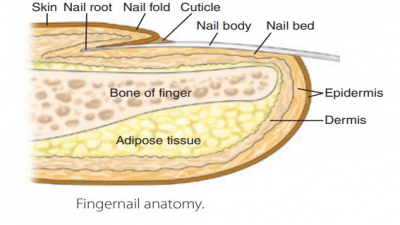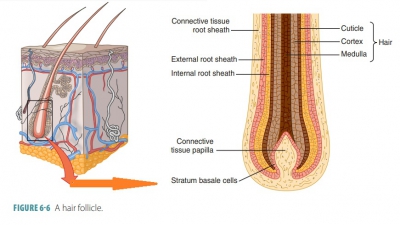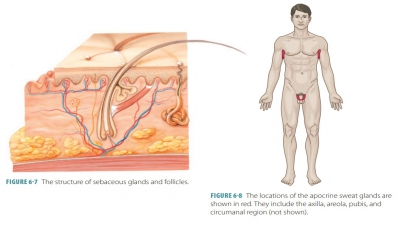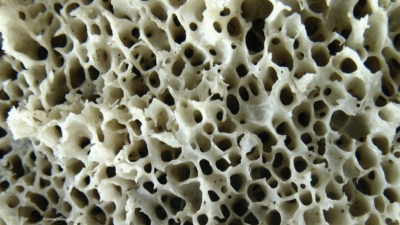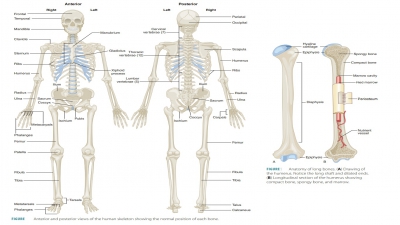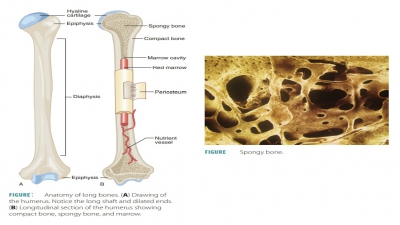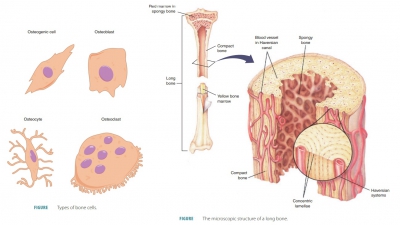Effects of Aging on the Integumentary System
| Home | | Anatomy and Physiology | | Anatomy and Physiology Health Education (APHE) |Chapter: Anatomy and Physiology for Health Professionals: Support and Movement: Integumentary System
1. What is the vernix caseosa that covers the skin of a newborn baby? 2. Why are elderly people less able to tolerate cold temperatures? 3. Why do skin wrinkles develop because of the aging process?
Effects of
Aging on the Integumentary System
Damaged skin affects almost every
body system. It leads to bone softening, impaired or accelerated metab-olism,
failure of the cardiovascular system, changes in immune function, and many
other outcomes. Intact skin can greatly improve quality of life in later years.
It protects the muscles, improving body temperature reg-ulation and blood flow.
Nervous system organs such as touch receptors are protected by intact skin. It
also pro-tects endocrine organs, prevents fluid loss, regulates normal
secretions, protects lymphatic organs to pre-vent edema, protects respiratory
organs for adequate oxygen supply, protects digestive organs for nutrient
absorption, protects urinary organs for proper excre-tion, and protects
reproductive organ health.
The skin initially develops from
either the embry-onic ectoderm (epidermis) or the mesoderm (dermis and
hypodermis). The skin is mostly formed by the end of the 4th month of
gestation. The fetus is covered with delicate colorless hairs (the lanugo coat) during months 5 and 6 of
gestation, but this coat disappears by the 7th month, replaced by vellus hairs.
At birth, the newborn’s skin is covered with vernix caseosa, a white substance that appears “cheese-like.” It is
produced by the sebaceous glands to protect the skin while the infant is still
inside the mother’s amnion. Small white spots appear on the forehead and nose
called milia, which are accumulations
in the sebaceous glands. They usually disappear by the 3rd week after birth.
The skin thickens during infancy and childhood, with more subcutaneous fat
being deposited. During adolescence, skin and hair both become oilier due to
activation of the sebaceous glands. Acne may develop during this time, which
usually subsides by early adulthood. The skin reaches its best appearance when
a person is in his or her 20s and 30s. Later, when it shows the effects of
abrasion, chemicals, sun, and wind, common condi-tions include scaling or dermatitis (skin inflammation). Atopic dermatitis or eczema is a genetic condition that is also exacerbated by environmental factors.
In older age, epidermal cells are
replaced less quickly. The skin becomes thinner and is more suscep-tible to
bruises and other injuries. It is less lubricated and often becomes dry and
itchy. Clumping of elastic fibers occurs. There are less collagen fibers and
they also become stiffer. Older people are unable to tolerate colder
temperatures as well because their subcutaneous fat layer diminishes. Fat
distribution becomes more sim-ilar between men and women because they have
lower levels of sex hormones than earlier in life. Wrinkling occurs due to
thinning of the epidermis and a decline of the protein elastin. Incidence of
skin cancer is higher because of decreased amounts of melanocytes and
den-dritic cells. Because they have less melanin than other people,
fair-skinned and redheaded people usually show age-related changes more
quickly. Hair thinning results by age 50, because active hair follicles are
two-thirds less prevalent. The hair loses its luster, and the genes activate
that trigger male pattern baldness and hair graying.
To slow skin aging, you should
shield your skin from the aging UVA rays and the burning UVB rays of the sun.
When protection from the sun occurs throughout life, aged skin will remain
unwrinkled and unmarked, although it still thins and loses a certain amount of
elasticity. Protective clothing and sunscreens or sunblocks of 15 (or higher)
sun protec-tion factors (SPFs) are encouraged. Although a nice tan may be
appealing early in life, sunlight eventually causes the skin to sag, wrinkle,
and become marked with pigmented “liver spots.” UVA rays activate matrix metalloproteinase enzymes, degrading dermal compo-nents such as
collagen. However, the skin aging pro-cess may be delayed by cleanliness, good
nutrition, plenty of fluid consumption, and the drug tretinoin (Retin-A®). This agent is related to vitamin A and
inhibits the matrix metalloproteinases. It is found in many skin creams
designed to slow photoaging.
In most people, signs of aging
generally appear by their late 40s. Signs of aging in the integumentary system
include thinning, graying hair, dry hair and skin, thinning skin, sagging skin,
bleeding within the skin, easier bruising, slower healing from injuries, and
recurring infections. Body heat regulation var-ies because of atrophy of blood
vessels, sweat glands, and subcutaneous fat. The skin may also show signs of
yellowing, mottling, age spots, and wrinkling. The most serious condition
affecting the skin during the aging process is skin cancer (discussed later).
With age, germinative cell activity declines, Langerhans cells decrease,
vitamin D3 production decreases, melano-cytes decline, glandular
activity declines, dermal blood supply reduces, and many hormones reduce in
level.
1. What is
the vernix caseosa that covers the skin of a newborn baby?
2. Why are
elderly people less able to tolerate cold temperatures?
3. Why do
skin wrinkles develop because of the aging process?
